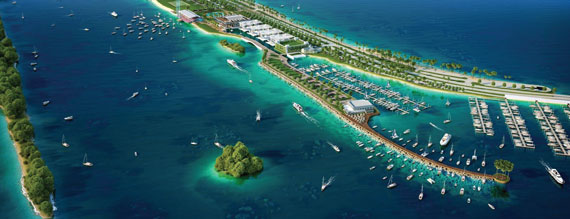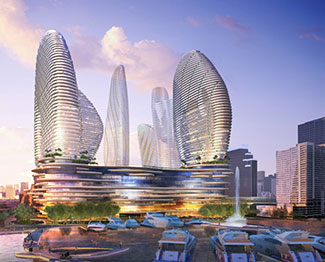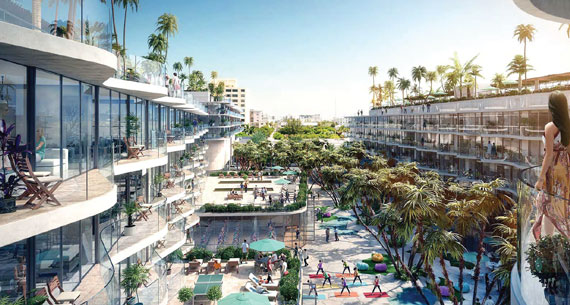In Miami, dreams of grand, ostentatious projects are often billed as set-in-stone reality by developers hoping to cash in on the city’s volatile real estate market. Yet, whether due to market forces, community opposition or political skulduggery, some “game-changing” projects never have reached the groundbreaking stage.
“People really believe announcing something is the same as doing it,” said Seth Gordon, a Miami public relations consultant who has represented a fair share of ambitious builders during a career that has spanned more than 30 years.
Billy Corben, a documentary filmmaker who has made a career producing movies that play on Miami’s huckster ingenuity, observed that Florida’s earliest settlers built the state on unfounded promises that, luckily for some of their proponents, turned out to be true.
For instance, when Indianapolis entrepreneur Carl Fisher arrived in Florida at the turn of the 20th century, he boldly proclaimed he would convert a swampy island into a bustling tourist mecca. One hundred years later, Miami Beach, the city Fisher founded, is going strong.
“If we didn’t originate it, we certainly mastered it,” Corben said, referring to Miami’s predilection for the grand plan. “We have a pretty good track record of promising projects that never happen.”
Even as the city has bounced back from the economic recession with a sizzling real estate market fueled by foreign capital, some recent projects have crashed as hard as October waves hitting the shoreline.
The Real Deal looked back at five such ill-fated projects, notable for their high profile and potential size and impact on Miami-Dade County.
Airport City
To jump-start the local economy during the Great Recession, in 2008 Miami-Dade County approved Odebrecht USA’s plan to build a $512 million commercial development with shops, a hotel and a conference center on 33 acres of public land near Miami International Airport. Odebrecht claimed that Airport City would generate half a billion dollars in revenue over 50 years. But bureaucratic entanglements and political agendas repeatedly delayed the project.
Some Cuban-American county commissioners unsuccessfully tried to dismiss Odebrecht’s bid, pointing out that the company is a subsidiary of a Brazilian conglomerate doing business in Cuba.
County staff, citing a need for more airport-related uses for the land due to an increase in international passengers, reduced Airport City’s footprint to just 9 acres. Miami-Dade County officials formally killed the Airport City project late last year after concluding that the county could make more money self-financing a hotel with a parking garage.
Miami Marine Stadium
Last fall a nonprofit group unveiled a $121 million plan designed to breathe new life into the Miami Marine Stadium, which was shuttered after sustaining Hurricane Andrew damage in 1992. Architects and business partners Hilario Candela (a designer of the original 1963 building) and Jorge Hernandez had been advancing the renewal of the waterfront entertainment site since co-founding the Friends of the Miami Marine Stadium in 2008.
In 2012, the Friends had entered into an agreement with the city to devise a redevelopment plan for the Virginia Key site that was presented last November. In addition to a renovation of the 6,566-seat stadium, the Friends proposed adding a 121,000-square-foot convention center, landscaped outdoor expo space, a 400-space parking garage and dry boat storage.
The nonprofit group also promised to raise $30 million in private funds to refurbish and reopen Marine Stadium, which the National Trust for Historic Preservation has listed as an endangered place. A few months later, however, the deal was nixed. In rejecting the deal, Miami Commissioner Marc Sarnoff said that Candela and Hernandez stood to benefit financially from serving as the project’s architects, according to the Miami Herald.
Both men bristled at the accusation, with Hernandez telling the Herald they were charging an industry standard fee of 4 percent of the project’s construction bill and Candela adding that they had funded surveys not paid for by the city.
In addition, Expo Miami —the private company that was to partner with the nonprofit group — received some negative publicity: Company co-founder Manuel Alonso-Poch resigned after city commissioners cited his past involvement in a financially troubled charter school. And Expo Miami’s chief financial officer, Federico Coupe, came under fire when the Daily Business Review reported he had filed for personal bankruptcy a month before the project’s submission.
The questions swirling around the architects and Expo Miami, combined with the Friends’ inability to show that its commitment pledges would turn into hard cash, convinced city commissioners to kill the deal, according to the Miami Herald.
Instead the city is moving forward with an estimated $18 million renovation of Miami Marine Stadium’s parking lot and boat slips in preparation for the 2016 Miami International Boat Show. The lot will be used for putting up tents during the annual February event and converted into a park the rest of the year.
Resorts World Miami
In 2011, when Malaysia-based Genting Group bought the Miami Herald’s former 14-acre headquarters for $236 million, it released an ambitious $3.8 billion redevelopment plan to transform the iconic waterfront property: A grand casino resort would be joined by four new hotels; two residential towers; 700,000 square feet of convention and meeting space; more than 50 restaurants, lounges, bars and nightclubs; a luxury retail galleria; a 3.6-acre rooftop lagoon and a natural sand beach.
But Genting met stiff resistance from nearby condo residents as well as patrons of the arts, who opposed having a casino in the emerging arts district that was set to include the Pérez Art Museum Miami and a future science museum at Bicentennial Park. Also, the Florida legislature was adamantly against giving Miami-
Dade County voters the chance to decide if they wanted casino resorts.
Two years ago, Genting announced a scaled-back, no-casino Resorts World Miami plan with just three condo towers and a luxury hotel, flanked by a 50-foot-wide promenade along the bay extending to Museum Park. Although the company has demolished the old Miami Herald building, no construction work has begun.
Michael Levoff, Genting Americas senior vice president for public affairs, said in September his company continues to refine its design and concept for the site: “We are committed to ensuring that our development is innovative, complementary to our surroundings and appropriately timed to meet the demands of the dynamic South Florida market,” he said.
500 Alton Road
Miami Beach developer Russell Galbut’s vision for a lofty, grand entrance to South Beach ultimately did not pass muster with Mayor Philip Levine. Nonetheless, Galbut is proceeding with a scaled-down project now called the Wave; that’s just one of four names it has had since the developer five years ago finished assembling a four-block stretch from Ninth to Fifth streets between Alton Road and West Avenue with the $8 million purchase of various parking lots. Galbut’s firm Crescent Heights had bought the main site, including the shuttered South Shore Hospital, for $28 million in 2004.
According to the city’s planning and zoning department, Crescent Heights has presented five proposals since 2012, referring to them alternately as the Wave, SoBe Park, 500 Alton Road and 600 Alton Road — and again the Wave earlier this year.
Back when the project was still called 500 Alton Road in 2014, Crescent Heights teamed up with the Related Group to propose a 50-story condo tower and an adjoining 3-acre public park from Fifth to Sixth streets. The 180-unit building would have been Miami Beach’s tallest structure and its condos would have been priced at about $1,200 a square foot. To sell his plan, Galbut said an artificial lake in the proposed park would capture and redirect stormwater from perennially flooded Alton Road.
But Levine didn’t buy in to this pairing of tower and park, forcing Galbut to abandon the plans. In email correspondence obtained by The Real Deal, the mayor referred to the project as “blatantly irresponsible development.”
This year, the Miami Beach Design Review Board forced Galbut to scale back a gargantuan mixed-use Wave project. Galbut had proposed constructing four new buildings, updating the shell of South Shore Hospital and cladding residential units with undulating balconies. The plan called for 541,653 square feet in total, 904 residential units and 1,499 parking spaces. The board ultimately approved a smaller version of the Wave, minus the curvaceous balconies, with just 321 apartments and some 50,000 square feet of retail space.
Ion East Edgewater
Plans for a 36-story tower in Miami’s hot Edgewater neighborhood collapsed in one of this year’s first development casualties. Sakor Development, a partnership between construction industry veteran Stephen Kornfield and former Related Group executive Barbara Salk, had sought to construct a 330-unit building at 2701 Biscayne Boulevard with 20,000 square feet of retail space that would be designed by Arquitectonica. Art Falcone’s Encore Capital Management agreed to be a partner in the project. The proposed amenities included a 75-foot heated lap pool, a Jacuzzi, a poolside cinema, private cabanas, an outdoor kitchen, a hammock garden, a fire pit, a bocce court and a fitness center.
But the plan stalled after the filing of a lawsuit by a neighboring property owner who objected to the closing of an alley. While the builder had presold 40 percent of the units, the lawsuit delayed the acquisition of the last parcel for the project site, according to a Sakor Development representative. Even though the plaintiff ultimately lost the litigation, Sakor was unable to complete the transactions for presold units. Some of the buyers ended up purchasing condos elsewhere, the company representative said.
In April, Sakor Development announced that it would reconfigure the site for a mixed-use development with residential, office and retail space.
Salk recently told The Real Deal that the plan has not changed.
“Our market research indicates this will ensure the highest and best use of the land, given appreciating values and the current development mix in what is quickly becoming one of Miami’s most desirable neighborhoods,” Salk said.





